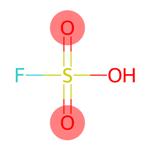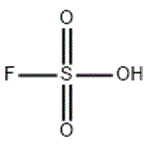Fluorosulphuric acid (FSO3H) is a free-flowing colourless fuming liquid. It is soluble in
polar organic solvents such as acetic acid, ethyl acetate, and nitrobenzene but poorly soluble
in nonpolar solvents such as alkanes. FSO3H is corrosive to metals and body tissues,
corrodes glass, and is incompatible with many metals and bases. With its strong
acidity, FSO3H dissolves almost all organic compounds that are even weak proton acceptors.
FSO3H hydrolyses slowly to HF and sulphuric acid (H2SO4). The related triflic acid
(CF3SO3H) retains the high acidity of FSO3H but is more hydrolytically stable. FSO3H is one
of the strongest known simple Bronsted acids. FSO3H is useful for regenerating mixtures
of HF and H2SO4 for etching lead glass. FSO3H isomerises alkanes and the alkylation of
hydrocarbons with alkenes, although it is unclear if such applications are of commercial
importance. FSO3H is used as a catalyst in organic synthesis and in electroplating and as
a fluorinating agent and as a laboratory fluorinating agent. FSO3H has been reported as
a highly toxic and corrosive chemical substance. FSO3H is non-combustible but enhances
combustion of other substances. It gives off irritating or toxic fumes (or gases) in a fire.
FSO3H hydrolyses to release HF. Addition of water to FSO3H causes very violent reactions
similar to the addition of water to H2SO4. Addition of FSO3H to water is a much more violent
process than addition of H2SO4. The combination of FSO3H and others is categorised
as ‘magic acids and super acids’. Very short contact and the fumes of FSO3H cause severe
painful burns.





